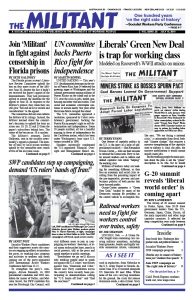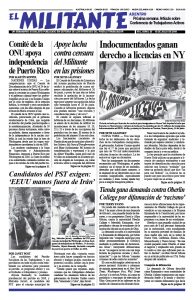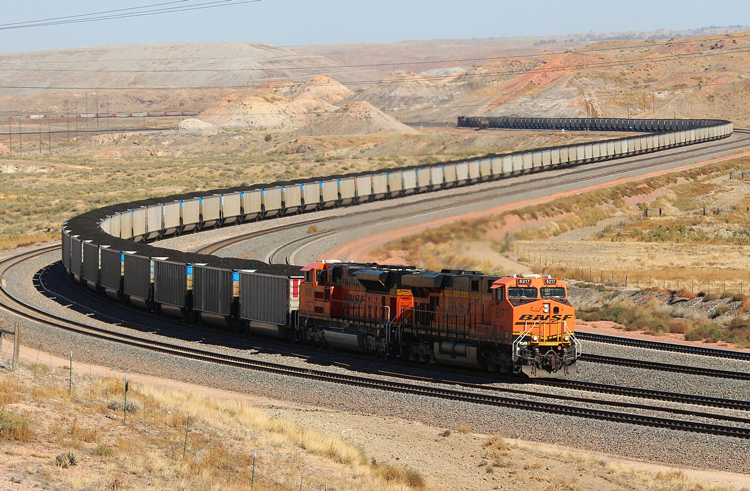LINCOLN, Neb. — A Union Pacific freight train containing cars carrying military munitions, including hand grenades, bombs and highly volatile ammonium nitrate, commonly used in explosives, from Nebraska to the U.S. Army Depot in Nevada, derailed June 19 as it traveled alongside US Interstate 80 near Elko. While none of the cars carrying munitions hit the ground, the crash did release aluminum oxide, a skin irritant. Sixty miles of the interstate was shut down for over an hour.
“We were very fortunate today,” Lt. Kevin McKinney of the Elko County Sheriff’s Office said. In 2004 a train carrying ammonium nitrate exploded in North Korea, killing at least 54 people and injuring over 1,000.
The near-disaster made many workers think of the July 2013 derailment and explosion of a 72-car oil train in Lac-Mégantic in Quebec, killing 47 people and levelling the center of the town.
There has been an increase in derailments, other “accidents,” and injuries and deaths of rail workers on North American railroads as the bosses push for more work assignments at a faster pace with less crew under anti-worker operating schemes like “precision scheduled railroading.” According to the Federal Railroad Administration, there have been 230 train derailments just through the end of May this year.
Many conductors and locomotive engineers see management’s first priority is shareholders’ returns as they ceaselessly grind on workers and equipment to maximize profits and stock value.
Workers are looking for ways to fight to defend themselves and those who live along the railroad right of way. “In my experience you can use the union to fight back,” Lance Anton, a BNSF Railway conductor and member of SMART-TD Local 0305, told the Militant June 27. “We recently pushed back the management here when they tried to shorten the training period for new workers.
“I support what the Socialist Workers Party raises in their program,” Anton said, “for trains with a maximum of 50 cars and a crew of four, two on the head end and two on the rear of the train. This is in the interest of all those who work the rails and working people who live near railroad tracks.”
Recently rail bosses ran a “test” of even longer, heavier trains, sending a 278-car coal train from the mines in the Powder River Basin in Wyoming to a power plant in Wisconsin. Over two and a half miles in length, it weighed 38,000 tons. This is an ominous precedent.
“It is not a ‘test’ anymore,” Anton reported, “since this spring BNSF Railway is regularly running 250 plus car coal and grain trains in and out of the Lincoln terminal, a major crew changing point on the system.”
New budget decisions by rail bosses have targeted training, cutting the length of their schools for new hires. In fact it takes three to four years to acquire experience working in the many area switchyards, road jobs and where to “spot” rail cars at local industries. Rail workers know that the bosses book of “rules” is pulled out whenever there is any kind of accident to scapegoat the workers.
Fight for workers control
Our union needs to fight for workers control of railroad training and operations, to fight for safe conditions and protect its members, and to extend that protection to those living, working or driving near the tracks.
For decades top union officials in North America have followed a course of class collaboration, looking to the Democrats and Republicans in state and federal government to pass laws setting a minimum crew size of two workers and other government regulations to slow down the bosses’ push for one- or no-person operations and automation.
Reliance on the legal system and government regulators not only doesn’t work, it does not prepare rail workers to use union power, and to reach out and win solidarity from other unionists and the working-class public — the only road to win a larger crew size, shorter trains and safe working conditions. Our own experience shows that looking to the rulers’ political parties and their government is a dead end, and it disarms us.
One recent example is the May 23 decision by the Federal Railroad Administration to withdraw a pending new rule that would have set a mandatory crew size of at least two for freight and passenger trains and to void all state laws and regulations that say the same. Our union had spent many hours and money to lobby for the larger crew. But the purpose of the FRA and similar government regulatory bodies is to protect the bosses and minimize the possibility of workers using the real power of the union — our numbers in action — under the guise of being “impartial” in its deliberations.
That’s why workers need to develop our ability to fight in our own interest. The place to start today is to win our unions to a course to fight in the interests of the whole working class, by mobilizing union power, the only real strength we have.
More training for new hires is a modest start, but it is a start on the road to using union power in the interest of those workers on the railroad.
Joe Swanson is a retired rail worker with 31 years’ experience. He lives in Lincoln, Nebraska, and remains active in his union local.


